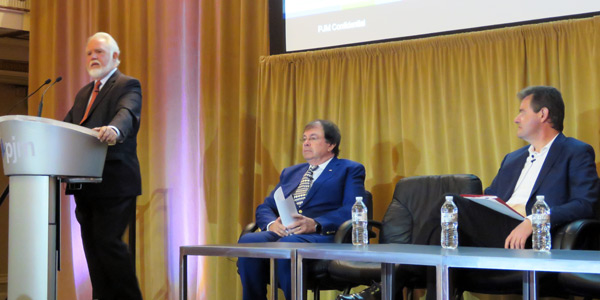By Rory D. Sweeney
CHICAGO — Nearly a century since its formation, PJM assured its members at its Annual Meeting last week that the future is as bright as it’s ever been.
“It’s been 90 years since three utilities — Philadelphia Electric, Pennsylvania Power and Light and Public Service Electric and Gas — decided that forming a power pool would be a more efficient way to meet reserve obligations and share power,” PJM CEO Andy Ott said. “We’ve been delivering value to our members ever since.”
Craig Glazer, PJM’s vice president of federal government policy, breezed through the grid operator’s first 70 years. He noted a New York Times article from 1928 that described the completion of PJM’s original 220-kV transmission ring between the territories of PECO, PPL and PSEG as a “superpower system.”
Former PJM CEOs Phil Harris (1992-2007) and Terry Boston (2008-2015) took it from there.
Harris described the transition from a coalition of regional utilities to an RTO independent of its founding companies. He joined PJM as a contractor in 1992 before being appointed CEO.
The utilities “realized they were going to be in competition one with the other and the solutions would change because there may be winners or losers among the companies,” Harris said. “We wanted to develop something that’s a team without losing the individuality” of each company, he said.
He described several “near misses” on opportunities that could have further transformed PJM. Among those was the creation of an even larger regional power pool that would allow the New York and New England systems to remain separate operationally but form a single market with PJM. One vote in opposition, from General Public Utilities, sank the idea, he said.
(Neither Harris nor any of the other speakers mentioned the circumstances under which he left PJM, resigning after a battle over the independence of the RTO’s Market Monitor, Joe Bowring. See State Regulators: FERC Probe into Bowring Allegations Fell Short.)
While Harris focused on development of the RTO’s structure, Boston’s remarks focused on its employees. He described efforts to entice high-level candidates with advanced electrical engineering degrees to PJM’s suburban Philadelphia headquarters. Now, more than 40% of PJM’s workforce has advanced degrees, he said. He also won board approval for a three-year rotational program for recently graduated engineers to gain experience in all of PJM’s departments before specializing in one.
Ott, who succeeded Boston in 2015, spoke of the support he’s received from the executive team Boston assembled. Ott, who has been at PJM for all of the 20 years it has been an RTO, noted “it feels like only yesterday we were working 23-hour days” to implement locational marginal pricing.
“The markets have evolved significantly over the past 20 years, and I think they will continue to do so,” he said.
PJM also honored its past and current board members, bringing Jean Kinsey (2007-2016), Carolyn Burger (1997-2005) and Richard Lahey (1997-2016) on stage to be recognized. Board Chair Howard Schneider, one of the original board members along with Lahey, acknowledged he will be retiring next year.
During a Members Committee meeting that completed the Annual Meeting, members re-elected incumbent board members Ake Almgren, Susan Riley and Charles Robinson to three-year terms.
PJM executives also provided reviews of the last year. Stu Bresler, senior vice president of operations and markets, said advanced technology has resulted in multiple enhancements, including transmission upgrades to reduce the risk of cascading outages and ways to measure “electrical distance” to ensure units located outside the RTO’s footprint can be relied upon if tied to the system. He said PJM is focused on reducing the day-ahead solution time to less than 2.5 hours in 2017.
Vince Duane, senior vice president of law, compliance and external relations, said the RTO is “probably looking at a suite of responses” to accommodate state public policy initiatives in PJM’s markets. The process is likely to be “politically challenging,” he said, but “there are ways to do it.”
In a later discussion with RTO Insider, he said PJM’s analysis on that is expected within a month. (See PJM Stakeholders Offer Different Takes on Markets’ Viability.)
Bowring said that coal remains economical and “a significant part of capacity” going forward as fuel costs continue to vary. LMPs in the first quarter of 2017 averaged $30.38/MWh, 13% higher than in 2016 due primarily to higher fuel prices, he said.
“The relative output of coal and gas, as long as those coal units stay around and are profitable — and many of them are — is going to switch depending on the relative cost of fuel,” he said.






